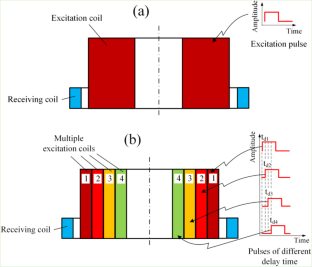Reduction of Pulsed Eddy Current Probe Footprint Using Sequentially Excited Multiple Coils
Abstract
In the detection of corrosion under insulation (CUI) using pulsed eddy current testing (PECT) method, it is of great significance to reduce the footprint of the probe for improving the spatial resolution to local corrosion. This paper presents a novel method to reduce the probe footprint by modifying the excitation coil into multiple sub-coils and driving them with sequential pulses of different delay time. Finite element simulations are conducted to reveal the underlying mechanism. It is found that by using the sequential excitation scheme, the diffusion and decay of eddy currents in the test piece are regulated, and both the footprint reduction and signal enhancement can be achieved. Afterwards, the effects of the sequence and the delay amount of the applying pulses on the probe footprint are analyzed. Results show that the optimal excitation sequence is to apply pulses with increasing delay time to the sub-coils from outside to inside; the probe footprint decreases with the increase of the delay amount. Experimental work is finally performed to verify the simulation results. A graphical method for measuring the probe footprint is proposed by moving the probe on a step wedge plate and plotting the evaluated thickness against the probe position. Footprint measurement results of a conventional probe and the presented 4-subcoil probe are compared. The effectiveness of the proposed method are validated and the differences between experimental and simulation results are analyzed.



 求助内容:
求助内容: 应助结果提醒方式:
应助结果提醒方式:


